

When Coffee and Kale Compete. 5 Tips For Writing A Job Story – Jobs to be Done. A Job Story is a powerful way to facilitate team conversation and discovery when designing products. They are meant to cut right to the job to be done by eliminating distractions. The job story encourages the product’s design process to focus on context, causality and motivations instead of assumptions, subjectiveness, personas and implementations.
Want more? Download a free PDF book about JTBD or buy it in paperback & kindle As I write more job stories, I’ve been paying attention to characteristics which make some stories better than others. Refine A Situation By Adding Contextual InformationJob Stories Come From Real People Not PersonasDesign Modular Job Stories Which Features (Solutions) Can Plug IntoAdd Forces To MotivationsJob Stories Don’t Have To Be From A Specific Point Of View 1. When David Wu described to me how a situation can capture a whole set of conditions, it struck a chord with me. The more context we have for the situation, the better I can design a solution. 2. 3. 4. Designing Features Using Jobs To Be Done. Personas and User Stories made sense when customers and product teams were far from each other.
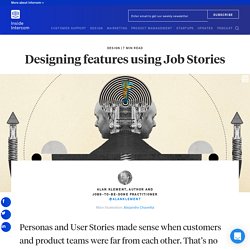
That’s no longer the case. This is a guest post from Alan Klement describing how one team used the design technique of Job Stories to design a profile page in a product. Traditionally, who the customer was and what they needed fell within the responsibility of marketing, business development, or even sales. After this information was gathered, it would be synthesized into a portable format and then pitched over the fence to a product development team, who was responsible for building the product. The casualties of this waterfall process are the subtleties which it is necessary to understand when creating great products: causality, anxieties, and motivations. Unpacking the Progress Making Forces Diagram. This week we talk through one of the tools that we use as we try to find Jobs-To-Be-Done: The Progress Making Forces Diagram.
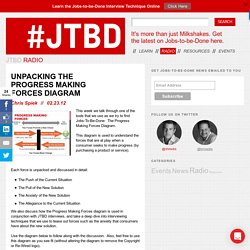
JTBD: How to Develop a Product Your Customers Actually Want. A Script To Kickstart Your Jobs To Be Done Interviews. It's not about product or service anymore - INNOVATION COPILOTS. Most industries seem to have a weak epiphany realizing that it’s maybe not about the product anymore, but service is important.
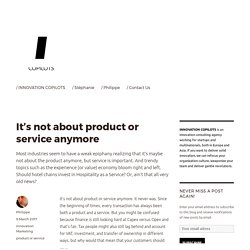
And trendy topics such as the experience (or value) economy bloom right and left. Outcome-Based Methods. What is Outcome-Based Segmentation™ ?
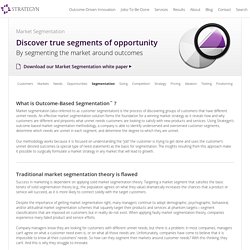
Market segmentation (also referred to as customer segmentation) is the process of discovering groups of customers that have different unmet needs. An effective market segmentation solution forms the foundation for a winning market strategy as it reveals how and why customers are different and pinpoints what unmet needs customers are looking to satisfy with new products and services. Using Strategyn’s outcome-based market segmentation methodology, a company is able to identify underserved and overserved customer segments, determine which needs are unmet in each segment, and determine the degree to which they are unmet.
Our methodology works because it is focused on understanding the “job” the customer is trying to get done and uses the customer’s unmet desired outcomes (a special type of need statement) as the basis for segmentation. How To Create A Useful Value Proposition w/ Examples. Value proposition is the #1 thing that determines whether people will bother reading more about your product or hit the back button.
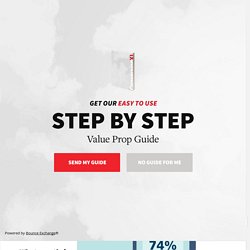
It’s also the main thing you need to test – if you get it right, it will be a huge boost. If I could give you only one piece of conversion optimization advice, “test your value proposition” would be it. [Tweet It!] The less known your company is, the better value proposition you need. When I reviewed a bunch of websites, the conclusion was that missing or poor value proposition is one of the most common shortcomings. Customer Value Propositions in Business Markets.
“Customer value proposition” has become one of the most widely used terms in business markets in recent years.
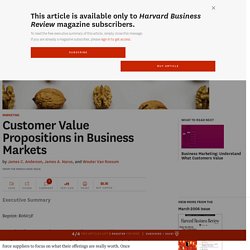
Yet our management-practice research reveals that there is no agreement as to what constitutes a customer value proposition—or what makes one persuasive. Moreover, we find that most value propositions make claims of savings and benefits to the customer without backing them up. An offering may actually provide superior value—but if the supplier doesn’t demonstrate and document that claim, a customer manager will likely dismiss it as marketing puffery. Customer managers, increasingly held accountable for reducing costs, don’t have the luxury of simply believing suppliers’ assertions. Take the case of a company that makes integrated circuits (ICs). Unbeknownst to the salesperson, the customer had built a customer value model, which found that the company’s offering, though 10 cents higher in price per IC, was actually worth 15.9 cents more.
The Customer-Centered Innovation Map. We all know that people “hire” products and services to get a job done.

Office workers hire word-processing software to create documents and digital recorders to capture meeting notes. Surgeons hire scalpels to dissect soft tissue and electrocautery devices to control patient bleeding. Janitors hire soap dispensers, paper towels, and cleansing fluid to help remove grime from their hands. While all this seems obvious, very few companies use the perspective of “getting the job done” to discover opportunities for innovation. In fact, the innovation journey for many companies is little more than hopeful wandering through customer interviews.